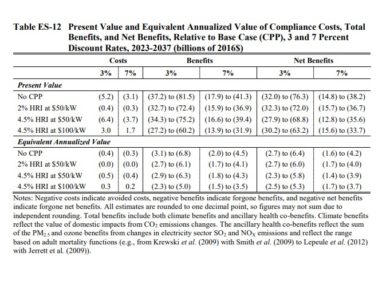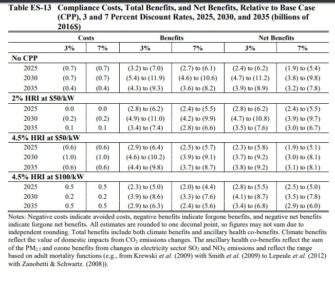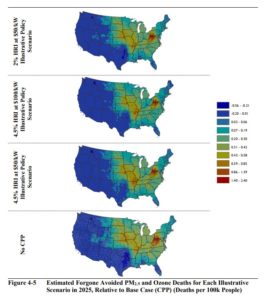The Costs, Benefits, and Health Impacts of EPA’s Proposed Replacement for the Clean Power Plan
EPA’s New Proposed Rule Will Cost Billions of Dollars, Largely in Health Impacts and Avoidable Mortality
As my colleagues Cara Horowitz and Meredith Hankins, and others, including the New York Times, have reported, the Trump EPA today proposed a replacement rule for the Clean Power Plan, which was a plan to transform our electrical grid away from coal (with associated health and climate benefits). The essence of the new proposal is to replace the Clean Power Plan, which required a shift in grid power away from coal, to a new plan that looks, on a plant-by-plant basis, to make modest efficiency improvements in existing coal-fired power plants. A quick look at the Regulatory Impact Analysis for EPA’s replacement for the Clean Power Plan (dubbed the “Affordable Clean Energy Rule” in an Orwellian twist) shows that it will cost the country, and especially the midwest (east to Pennsylvania and West Virginia), significantly in comparison with the Obama Administration’s Clean Power Plan rule. In short, more people will get sick and die- enough more to far more than make up for the costs that coal power plant operators will avoid, or any economic benefits to communities- under the new rule.
Confusingly, the analysis also compares the rule to a complete CPP repeal scenario as an “alternative baseline,” and finds significant reductions in CO2 and co-pollutants “compared to a no CPP scenario.” But that “no CPP scenario” is a made-up scenario, since the existing rule is the CPP, which this new rule replaces.
EPA also has put out a “fact sheet” that ignores the high health costs and climate impacts of the new rule.
But the real impacts calculated by EPA are in the regulatory impact analysis.
The tables and charts in the analysis are hard to read at first glance, for three reasons. First, as noted above, it uses both a CPP baseline and an “alternative baseline” of full repeal. Second, many of the featured tables disaggregate costs and benefits into “targeted pollutant (CO2)” and “co-pollutants,” which blunts the full impact. And finally, there are 3 different scenarios for implementation, reflecting different assumptions about future improvements in HRI (which means heat rate improvement, the efficiency improvement EPA has selected as the best system of emissions reduction) and the cost of implementing those improvements.
But the information is there, even if it’s hard to find. These two tables, at ES-16 and ES-17 of the regulatory impact analysis, provide the bottom line comparison to CPP. Look at the “net benefits” on the right side of the table in each of the three scenarios. The parenthetical numbers there represent billions of dollars in foregone net benefits–benefits lost in the new proposed rule– compared with the Clean Power Plan.
Most of the foregone benefits represent increases, compared with the Clean Power Plan, in pollution that harms and kills people– and most of those affected are in the midwest, east to Pennsylvania and West Virginia. Chapter 4 of the analysis contains detailed info on expected premature illness and deaths from the new rule, compared with the Clean Power Plan. These include the following two maps that show the predicted increases in ozone and particulate matter pollution and related increases in premature death and morbidity (“foregone avoided deaths”).
The new proposed rule is neither clean nor affordable, despite the rhetoric.










Reader Comments